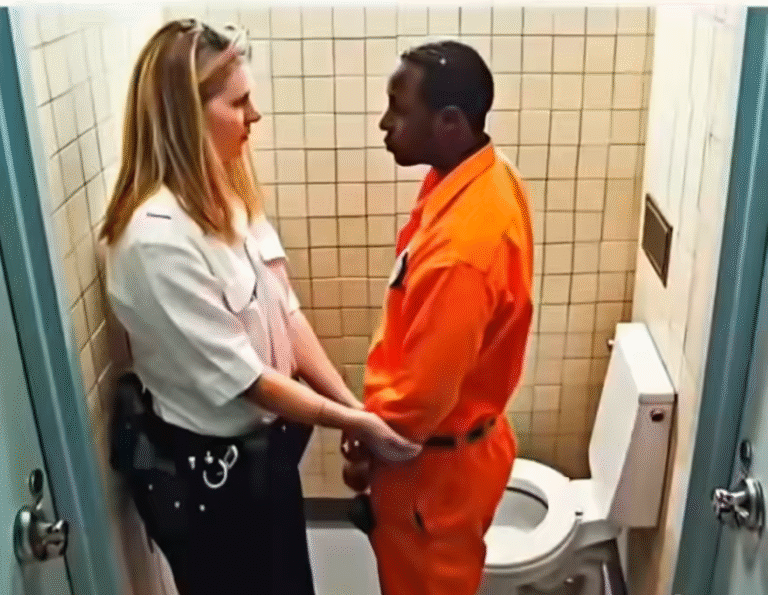
What really happens behind prison walls when the enforcers of order become entangled with those they’re meant to oversee?
It sounds like fiction: forbidden relationships, contraband smuggling, and whispered escape plans. But recent scandals across the U.S. correctional system reveal a reality more unsettling than rumor. These are not just lapses in judgment—they’re breaches of authority, of ethics, and of the thin line between power and vulnerability.
When Guards Cross the Line
In recent years, multiple cases have emerged in which female correctional officers were charged with engaging in sexual or criminal relationships with male inmates. These stories have moved from isolated incidents to a disturbing pattern—one that exposes how personal vulnerabilities and institutional failures can collide in devastating ways.
One of the most glaring cases unfolded at a high-security prison in California, where a 28-year-old officer was arrested after an investigation revealed her sexual relationship with a known gang member. She not only met with him in secret but also smuggled in a cellphone—ensuring their connection continued far from the watchful eyes of security cameras.
When questioned, she didn’t deny it. “I fell in love,” she confessed. Surveillance footage and intercepted texts painted a clear picture: this wasn’t coercion—it was a deliberate, if misguided, choice. But that distinction doesn’t lessen the fallout.
And it wasn’t an outlier.
From Michigan to Texas, from small county jails to federal institutions, cases have surfaced where officers crossed ethical and legal lines—sometimes for money, sometimes for affection, sometimes for reasons harder to explain. In some cases, the consequences were merely disciplinary. In others, they were catastrophic.
One infamous case from New York still lingers in the public imagination: a female prison employee aided in a high-profile escape by smuggling hacksaw blades inside frozen meat. That incident was so bizarre—and so sensational—it inspired Showtime’s Escape at Dannemora. But the reality behind it was anything but entertaining: it was a glaring failure of oversight and accountability.
The Environment That Breeds Vulnerability
Experts say the very nature of prison work creates conditions where boundaries can erode. Long hours, emotional fatigue, and the psychological toll of working in high-stress, high-risk environments often go unaddressed.
“Prisons are pressure cookers,” says Dr. Karen Ellis, a criminal psychologist specializing in correctional environments. “People working inside them are constantly managing conflict, often without adequate emotional support. Add isolation, low morale, and exposure to manipulative behavior, and the risk of boundary-crossing increases significantly.”
But manipulation is only one piece of the puzzle. In some cases, it’s not inmates preying on guards—but guards willingly making choices that jeopardize their careers and public safety. Whether it stems from loneliness, misplaced empathy, or thrill-seeking, the result is the same: a breach of duty.
The Cost of Compromise
Even in cases where the relationship appears consensual, the law takes a hard line. Inmates cannot legally consent to sexual relationships with staff, placing officers at risk of felony charges. Termination, reputational ruin, loss of benefits, and potential jail time often follow.
The consequences for the inmates involved can be equally severe—solitary confinement, reduced privileges, and damage to parole eligibility. And while some may have manipulated their way into these situations, others are punished regardless of their role in initiating the relationship.
Reform or Reaction?
In response to rising incidents, correctional systems are tightening training, expanding surveillance, and introducing new psychological support systems. But some argue these are reactive measures—not true reform.
Female officers, who now represent a significant portion of the correctional workforce, are calling for more robust emotional resilience programs and better institutional safeguards—both to protect themselves and to prevent exploitation.
Still, each new headline raises difficult questions: How often does this happen without being caught? And can trust in the system be restored once it’s broken?
Conclusion
These aren’t just stories of misconduct. They are indicators of something deeper—a system under strain, where emotional fatigue meets institutional neglect. The officers at the center of these scandals are not always predators, nor always victims. But every case reveals a crack in the foundation: blurred lines, compromised integrity, and consequences that extend far beyond the individuals involved.
Until prisons address both the psychological toll on staff and the structural weaknesses that enable these breakdowns, the line between keeper and kept will remain perilously thin—and easily crossed.




